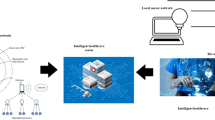Abstract
Artificial intelligence is intelligence revealed by software, as opposed to natural intelligence. It is the science and technology of intelligent machinery. It is also a technology that functions like people on the computer. The IoT Internet of Things is a web-based object network that can communicate and share data. AI and IoT are combined to achieve a more effective IoT process, namely AIoT, combined with the Internet and artificial intelligence. Recently, an efficient health care system was introduced with artificial intelligence (AI) and IoT research. In this paper, the usability of artificial intelligence is discussed, and the implementation of AI and IoT analytics are systematically examined as a way of enhancing the health system in the IoT model. Different AI-based and device algorithms are also explored. Edge Computing is a modern computer technology in which data are processed from the edge. Simulation result shows the accuracy, precision and specificity of decision tree approach than SVM and Naïve Bayes. It offers lower bandwidth costs, more robust privacy and data security than cloud computing. Notably, advanced computing is easily used by artificial intelligence technologies.








Similar content being viewed by others
References
Bano, A., Din, I. U., & Al-Huqail, A. A. (2020). AIoT-based smart bin for real-time monitoring and management of solid waste. Scientific Programming, 2020, Article ID 6613263.
Jung, W., Kim, S., Hong, S., & Seo, J. (2021). An AIOT monitoring system for multi-object tracking and alerting. Computers, Materials & Continua, 67(1), 337–348.
Kshirsagar, P., & Akojwar, S. (2016). Hybrid heuristic optimization for benchmark datasets. International Journal of Computer Applications, 146(7), 11–16.
Kshirsagar, P., Akojwar, S., & Bajaj, N. D. (2018). A hybridized neural network and optimisation algorithms for prediction and classification of neurological disorders. International Journal of Biomedical Engineering and Technology, 28(4), 307.
Panigrahi, S. S., & Rout, N. K. (2017). AIOT based old age support system. International Journal of Computational Engineering Research (IJCER), 7, 57–64.
Poniszewska-Maranda, A., & Kaczmarek, D. Studying usability of AI in the IoT systems/paradigm through embedding NN techniques into mobiles mart service system. In Proceedings of the IEEE 18th international conference on computer supported cooperative work in design (CSCWD) (pp. 493–498). IEEE.
Shirazi, S. N., Gouglidis, A., Farshad, A., & Hutchison, D. (2017). The extended cloud: Review and analysis of mobile edge computing and fog from a security and resilience perspective. IEEE Journal on Selected Areas in Communications, 35(11), 2586–2595.
Kshirsagar, P., & Akojwar, S. (2016). Optimization of BPNN parameters using PSO for EEG signals. In Proceedings of the international conference on communication and signal processing, 2016 (ICCASP 2016).
Zhao, K., & Ge, L. (2013). A survey on the internet of things security. In Computational intelligence and security (CIS), 2013 9th international conference on (pp. 663–667).
Ali, I., Sabir, S., & Ullah, Z. (2016). Internet of things security, device authentication and access control: A review. International Journal of Computer Science and Information Security, 14, 456.
Kshirsagar, P., & Akojwar, S. (2016). Prediction of neurological disorders using optimized neural network. In International conference on signal processing, communication, power and embedded system (SCOPES).
Arsénio, A., Serra, H., Francisco, R., Nabais, F., Andrade, J., & Serranol, E. (2014). Internet of intelligent things: Bringing artificial intelligence into things and communication networks. Berlin: Springer.
Kshirsagar, P. R., Chippalkatti, P. P., & Karve, S. M. (2018). Performance optimization of neural network using GA incorporated PSO. Journal of Advanced Research in Dynamical and Control Systems, 10(4).
Dinh, H. T., Lee, C., Niyato, D., & Wang, P. (2013). A survey of mobile cloud computing: Architecture, applications, and approaches. Wireless Communications and Mobile Computing, 13(18), 1587–1611.
Rathish, C. R., & Rajaram, A. (2017). Robust early detection and filtering scheme to locate vampire attack in wireless sensor networks. Journal of Computational and Theoretical Nanoscience, 14(6), 2937–2946.
Author information
Authors and Affiliations
Corresponding author
Ethics declarations
Conflict of interest
The authors declare that they have no conflict of interest.
Additional information
Publisher's Note
Springer Nature remains neutral with regard to jurisdictional claims in published maps and institutional affiliations.
Rights and permissions
About this article
Cite this article
Padmaja, M., Shitharth, S., Prasuna, K. et al. Grow of Artificial Intelligence to Challenge Security in IoT Application. Wireless Pers Commun 127, 1829–1845 (2022). https://doi.org/10.1007/s11277-021-08725-4
Accepted:
Published:
Issue Date:
DOI: https://doi.org/10.1007/s11277-021-08725-4




